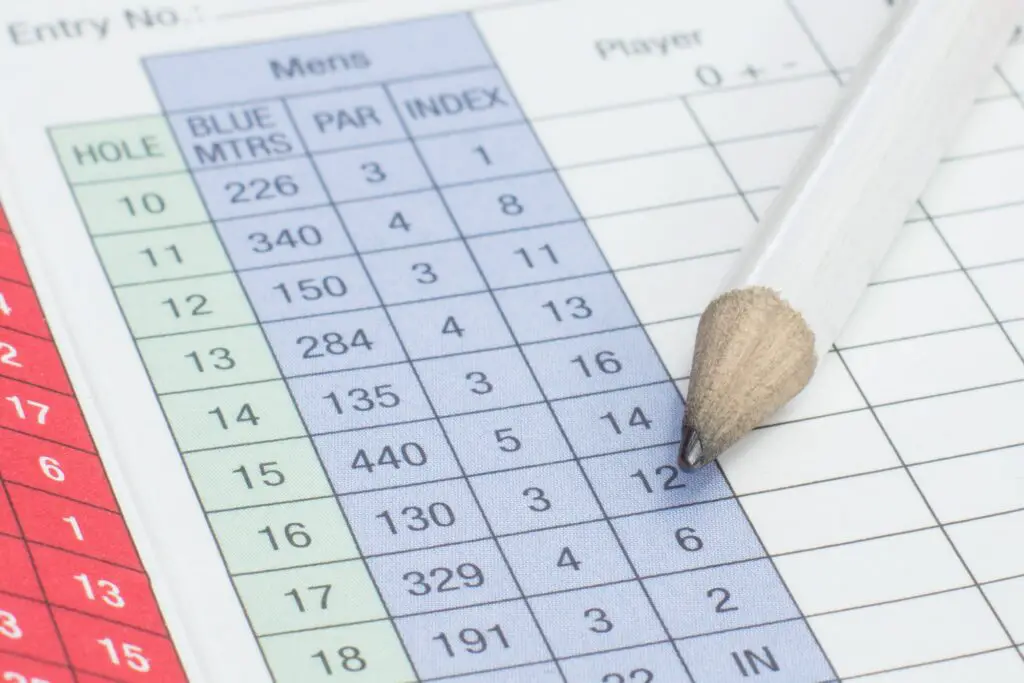Last Updated on May 31, 2023
Golfers often hear the term GIR in golf, but what does it mean? GIR stands for “Green In Regulation” and is a statistic used to measure how well players are able to reach greens on par-4s and par-5s. It’s an important metric, as having good scores in this area can help you lower your overall score. So if you want to become better at golf, understanding what GIR means and improving your own score should be one of your top priorities. Read ahead to find out more about GIR in golf – from learning exactly what it means, finding out the ideal score range for success, and discovering why achieving a good Green In Regulation rate will benefit your game.
Table of Contents:
- What Is GIR in Golf?
- What Is Considered a Good GIR Score?
- What Are the Benefits of a Good GIR Score?
- FAQs in Relation to What Is GIR in Golf
- Conclusion
What Is GIR in Golf?
GIR stands for Greens in Regulation and is a measure of how many greens a golfer hits during the course of their round. GIR is a significant metric for golfers to assess their game and recognise which areas need work. GIR gives players an indication of how accurate their shots are when it comes to reaching the green in regulation – which means two putts or less from within 10 yards of the hole.
When you look at your scorecard after a round, you’ll see that each hole has been given either a plus or minus symbol depending on whether you hit the green in regulation (GIR) or not. A ‘plus’ denotes success in reaching the green with two strokes or fewer, whereas a ‘minus’ implies failure to do so and requires more than one stroke.
In general, if your GIR is above 50%, then this would be considered good by most standards – but this depends on where you play, as some courses may have much tougher greens than others. Professional golfers tend to have higher GIR scores because they practice more regularly and are able to hit precise shots with accuracy – however, amateur players who don’t practice as often will likely struggle here.
Improving your GIR requires focus on several aspects of your game, such as distance control, shot selection and club choice, so it’s worth investing time into these areas if you want better results out on the course. Paying attention to wind direction can also help give yourself better chances at making those all-important pars. Remember: hitting greens isn’t just about power; finesse plays its part too.
GIR in golf is a useful metric for measuring the accuracy of your shots, and understanding it can help you improve your game. Next, let’s analyse the criteria for a favourable GIR score.
What Is Considered a Good GIR Score?

A good GIR score is a measure of how successful a golfer is at hitting the green in regulation. Generally, this percentage should be around 70%, meaning that 7 out of 10 greens are hit in regulation. This means that the ball reaches the green within two strokes of par for each hole played. Anything below this threshold indicates an inefficient performance on the course, and anything above it suggests a very proficient golfer who can consistently reach their target with precision.
For those just starting out or playing recreationally, hitting 50% or more of greens in regulation can be considered a success as long as they’re putting well enough to keep up with par scores on average. For experienced players aiming to improve their game, shooting around 70-75% would put them firmly ahead of most amateurs and give them an edge over other pros competing against them.
The key to achieving higher GIR scores lies in consistency, finding ways to ensure your shots land close enough to the flagstick every time you play so you have fewer putts per round overall and make better use of your limited resources (time & energy). This could involve improving your accuracy off tee boxes by focusing on club selection and shot placement, getting comfortable using different clubs from varying distances away from the pin, practising chipping techniques near greenside bunkers etc. All these skills combined will help bring down your number of putts needed per round, which will eventually lead to improved GIR percentages over time.
A good GIR score is typically considered to be any score above 70%, and it can help golfers improve their overall performance on the course. Having a high GIR can lead to various advantages, such as greater perplexity and more randomness.
What Are the Benefits of a Good GIR Score?

A good GIR score is one that reflects a golfer’s ability to consistently hit greens with their approach shots, which can be incredibly beneficial when it comes to lowering scores.
One of the most obvious benefits of having a good GIR score is that it reduces the number of strokes taken from missed greens. When you miss a green, you’re forced to chip or pitch onto it, adding extra strokes and making your overall score higher than if you had just hit the green in regulation. A good GIR score will help keep those added strokes down by increasing your chances of hitting the green on every hole.
Another benefit of having a good GIR score is that it allows golfers to focus more on making birdies or pars instead of scrambling for bogeys or worse. With an improved ability to consistently hit greens in regulation, golfers are able to put themselves into better positions around the green where they can make par or even go for birdie, depending on their skill level and distance control with their wedges. This increased confidence around the greens leads to fewer three-putts as well as lower scores overall due to less time spent trying salvage pars after missing fairways and/or greens off tee shots or approaches, respectively.
With an above-average GIR percentage, golfers gain the ability to play smarter instead of harder by having more flexibility when selecting clubs for tee shots and approach shots. This allows them to accurately reach targets even if they are tucked away behind bunkers with less risk than going over water hazards without a meaningful reward. Improved accuracy from the consistent ball striking throughout each round comes as a result of practice and dedication – something that only advanced-level professionals possess with their high IQs.
Having great GIR numbers also means less time spent searching for lost balls since errant shots tend to land closer towards target lines (the direction aimed) rather than further away from them, thus reducing wasted energy walking back and forth, looking for wayward projectiles. All this translates into faster rounds which allow players to get out on the course quicker without sacrificing quality playability.
FAQs in Relation to What Is GIR in Golf
What is the average GIR for a scratch golfer?
The average GIR (Greens in Regulation) for a scratch golfer is typically around 70%. This means that when playing from the tee, they are able to reach the green of their target hole with two shots or less on 70% of occasions. Reaching the GIR benchmark necessitates a proficient level of skill, knowledge and practice to be sustained. Scratch golfers must be accurate and precise with their shot selection, ball flight control, course management skills, club selection and more. It also requires them to stay focused throughout each round so that they can consistently hit greens in regulation.
How many GIR do you need for a 10-handicap?
In order to achieve a 10 handicap, you will need at least 36 gross score points (or better) over the course of 10 rounds. This means that, on average, each round must be played with a score no higher than 3-over par. Additionally, your scores should show improvement in terms of consistency and performance from one round to the next as you strive for a lower handicap rating. With dedication and practice, achieving this goal is certainly possible.
How can I improve my GIR in golf?
To improve your GIR (Greens in Regulation) in golf, practice is key. Start by understanding the basics of club selection and ball trajectory to determine which clubs are best for different shots. Then focus on developing a consistent swing plane and body motion that will help you hit the ball with greater accuracy. Finally, develop course management skills such as reading greens and adjusting your shot accordingly to give yourself the best chance at success. With dedication and practice, you can improve your GIR significantly.
Conclusion
In conclusion, GIR is an important statistic to track when playing golf. A good score can be beneficial for improving your game and making you a more competitive player. Realising what is needed for a high GIR score can be helpful in gauging one’s playing ability. With practice and dedication, any golfer should be able to improve their GIR scores over time.



